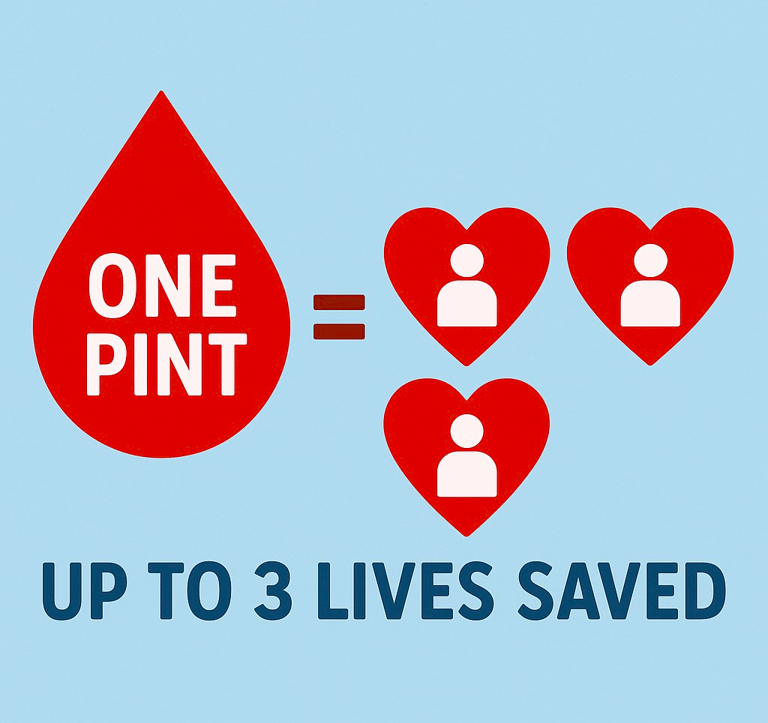Stay updated on what is trending in health. Discover tips and resources for a healthier, balanced life.
Are You Scared to Donate Blood? Here’s Why You Shouldn’t Be—and How It Could Save a Life
Donating blood is safe, quick, and can save up to three lives. Learn what really happens when you donate blood, how your body recovers, and tips to feel your best post blood donation.
HEALTHCARE SERVICES
Dr. S. Ali
6/14/20254 min read


Let’s be honest—the idea of donating blood can feel scary for a lot of people. Maybe it’s the sight of a needle, or the thought of feeling weak afterward. If that’s you, you're not alone. But here’s the thing: donating blood is one of the simplest, quickest, and most powerful ways to save lives.
So… Why Do People Need Blood?
Every few seconds, someone in the world needs a blood transfusion. It could be a trauma patient after an accident, a child with leukemia, a mother with complications after childbirth, or someone undergoing major surgery.
And guess what? There’s no substitute for human blood. It has to come from someone willing to donate.
One Pint of Blood Can Save Up to Three Lives
That’s right. Just one donation can help up to three people. Your body replenishes the lost blood quickly, but for the person receiving it, it could mean the difference between life and death.
When you donate one pint of blood, it’s not just a single gift—it can become multiple lifesaving treatments.
Here’s what happens:
The donated blood is usually separated into different components: red blood cells, plasma, and platelets.
Each of these parts can be given to different patients depending on their specific medical needs.
Red blood cells help patients who have lost blood from surgery, trauma, or anemia.
Platelets are essential for patients with cancer or blood disorders to help their blood clot.
Plasma is used for patients with burns, liver disease, or serious infections.
Because these components can be used separately, one pint of blood can help up to three different patients, effectively saving up to three lives.
While donating blood can have a tremendous impact on saving lives, you might wonder if giving up that much blood is safe for you—and how your body manages to recover afterward. Let’s take a closer look at what happens when you donate and why it’s safe for most people.
Can Someone Feel They Are Losing Much-Needed Blood When Donating?
When you donate one pint of blood, it’s a small amount compared to the total blood volume in your body (which is about 10 pints for an average adult). Most healthy people do not feel weak or notice a significant loss because the body is well-equipped to handle this.
Some people might feel a little dizzy or tired right after donating, but these feelings usually pass quickly.
Blood donation centers carefully check your health before you donate to make sure it’s safe for you.
How Does the Body Replenish the Lost Blood?
Your body begins to replace the lost blood right away:
Plasma (the liquid part): Replenished within about 24 to 48 hours by absorbing fluids from tissues and increasing fluid intake.
Red blood cells: Take longer to replace—usually a few weeks. Your bone marrow produces new red blood cells steadily.
Platelets and white blood cells: Also regenerate fairly quickly, typically within a few days.
That’s why it’s safe to donate blood about every two months or so—the body has enough time to fully recover.
Nervous? Here’s What Actually Happens
Here’s what to expect when you donate blood — plus some easy tips to help you feel your best afterward.
First, you’ll fill out a brief form and have a quick health check to make sure you’re ready to donate.
Then, you’ll sit or lie down comfortably while the donation takes place.
The actual blood draw usually takes about 10–15 minutes.
You might feel a quick pinch when the needle is inserted, but most people don’t feel pain afterward.
Taking care of yourself afterward is just as important — here’s how to help your body recover smoothly and feel your best.
Rest for a few minutes and enjoy a light snack and drink provided at the donation center. This helps restore your energy and blood sugar levels.
Drink plenty of fluids for the next 24–48 hours to help your body replace lost plasma.
Avoid heavy exercise or strenuous activity for the rest of the day.
If you feel dizzy or lightheaded, sit or lie down until you feel better.
And the best part? You leave knowing you’ve done something incredible.
Professional tip:
Make sure to eat a healthy meal before donating, stay hydrated, and get a good night’s sleep the day before to help your body handle the donation smoothly.
Common Fears—And the Truth
“I’m scared of needles!”
Totally understandable. But most donors say the fear was worse than the actual experience.
“I’ll feel weak or faint.”
Most people feel just fine afterward. Eat a good meal beforehand and stay hydrated—you’ll bounce back quickly.
“I don’t know if I’m eligible.”
Blood donation centers do a quick screening to make sure it’s safe for you to donate. Many healthy people qualify!
A Small Act With a Huge Impact
Blood can’t be stockpiled forever—it expires. That’s why regular donations are so important. Your single act today could help:
A child fight cancer
A father survive heart surgery
A crash victim recover in time
You never know who you might be saving.
Professional Tip:
If you’re healthy and eligible, donating blood is a safe, quick, and deeply meaningful act. And if you’ve never done it before, try going with a friend—it’s a great way to support each other and ease the nerves.
You’re Braver Than You Think
Still nervous? That’s okay. But remember: the fear is temporary. The life you save is real. And trust me—you’ll walk out of that donation center a little lighter, and a whole lot prouder.
Sources:
World Health Organization (WHO)
https://www.who.int/news-room/fact-sheets/detail/blood-safety-and-availabilityAmerican Red Cross
https://www.redcrossblood.org/donate-blood/blood-donation-process.htmlCenters for Disease Control and Prevention (CDC)
https://www.cdc.gov/bloodsafety/index.htmlNHS Blood and Transplant (UK)
https://www.blood.co.ukWorld Blood Donor Day – WHO Campaign Page
https://www.who.int/campaigns/world-blood-donor-dayNIH Blood Bank
https://www.cc.nih.gov/bloodbank/know-before-you-goSan Diego Blood Bank
https://sandiegobloodbank.org/donors/after-you-donate/Stanford Blood Center
https://stanfordbloodcenter.org/donate-blood/blood-donation-facts/post-donation/
Pulse Your Health
Empowering you to achieve your health goals.
Contact
© 2025. All rights reserved.
Disclaimer: The content on this website is for informational purposes only and is not medical advice. Always seek the advice of your physician or other suitably qualified healthcare professional for diagnosis, treatment and your health related needs.
